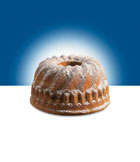CakeZyme™ is an enzyme that hydrolyzes lipids (emulsifier-type molecules) into more functional so-called lyso-lipids, which are stronger emulsifiers. By incubating whole eggs or egg yolk with CakeZyme, the functionality of the eggs is upgraded in cake production. This means fewer eggs can be used, reducing cholesterol content of the cake. CakeZyme can also deliver a slight reduction in the product’s fat content. However, it is not intended to fully replace fat. To achieve a significant fat reduction, but still deliver the right mouthfeel and buttery taste, CakeZyme can be used in combination with other ingredients.
Egg is added to cake formulas for emulsification properties (among other things). The active component in eggs for emulsification is egg lecithin. CakeZyme converts lecithin into lyso-lecithin, which is a stronger emulsifier. Because it is stronger, the amount of egg required can be reduced by up to 20%.
CakeZyme does not break down starch, but lyso-lecithin is able to complex with starch, thereby preventing it from recrystallizing. Recrystallization, or retrogradation, causes a hardening of the cake structure, contributing to staling. By using CakeZyme, a softer structure is obtained directly after cooling and also on the shelf. As a result, a four-week-old cake still tastes fresh.

Cake formulas are complicated systems. All ingredients in the formula need to be in the right balance to achieve the perfect cake.
Use Level
Cake formulas are complicated systems. All ingredients in the formula need to be in the right balance to achieve the perfect cake. That is why the optimum amount of CakeZyme varies according to the formula and product. It is not to be assumed that using a higher quantity of CakeZyme will necessarily lead to an even better quality cake.CakeZyme enables formulators to realize up to a 20% egg reduction in a formula—typically resulting in a significant cost savings. The use level depends on the product type and recipe, but generally falls between 0.02% and 0.2% of the formula egg weight. The addition of CakeZyme significantly enhances emulsification, resulting in lower batter density, improved batter viscosity and delayed crumb setting. Consequently, the finished product will show increased volume, improved crumb structure and softness with a longer shelflife.
Other baked products containing eggs (if egg is used for emulsification) can, in principle, benefit from use of CakeZyme. Presently, experiments with CakeZyme are taking place with brioche and biscuits.
Labeling
According to DSM, CakeZyme can be considered a processing aid and, therefore, does not require labeling according to 21CFR 101.100.One ingredient solving so many issues has the potential to be successful in helping a variety of manufacturers.
For more information:
DSM Food Specialties • Netherlands
José Mastenbroek • +31 15 279 4001
info.bakingenzymes@dsm.com
www.dsm-bakingenzymes.com